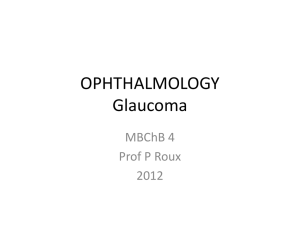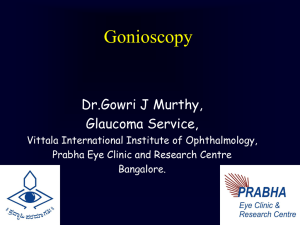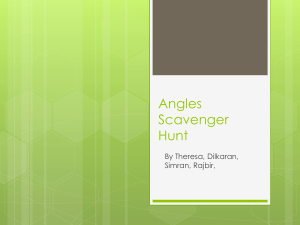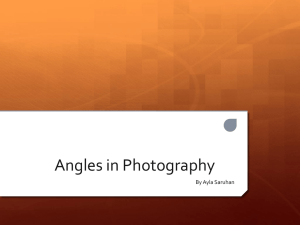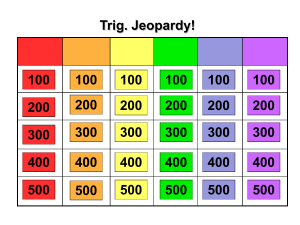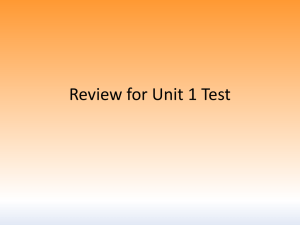Gonioscopic Examination for Glaucoma
advertisement
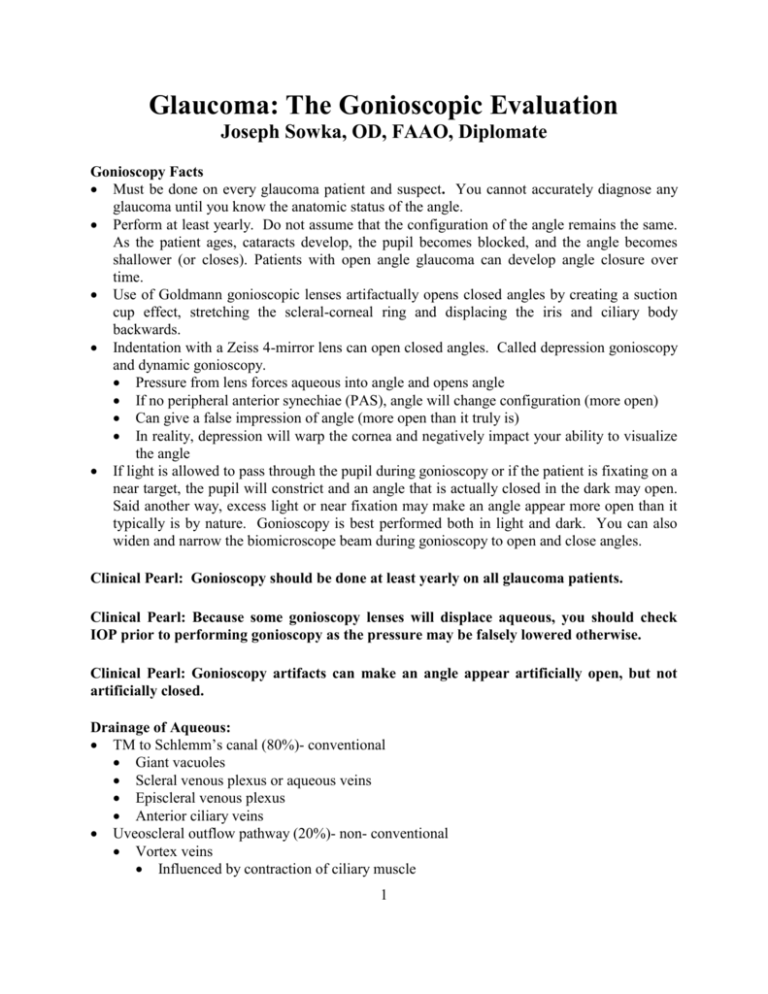
Glaucoma: The Gonioscopic Evaluation Joseph Sowka, OD, FAAO, Diplomate Gonioscopy Facts Must be done on every glaucoma patient and suspect. You cannot accurately diagnose any glaucoma until you know the anatomic status of the angle. Perform at least yearly. Do not assume that the configuration of the angle remains the same. As the patient ages, cataracts develop, the pupil becomes blocked, and the angle becomes shallower (or closes). Patients with open angle glaucoma can develop angle closure over time. Use of Goldmann gonioscopic lenses artifactually opens closed angles by creating a suction cup effect, stretching the scleral-corneal ring and displacing the iris and ciliary body backwards. Indentation with a Zeiss 4-mirror lens can open closed angles. Called depression gonioscopy and dynamic gonioscopy. Pressure from lens forces aqueous into angle and opens angle If no peripheral anterior synechiae (PAS), angle will change configuration (more open) Can give a false impression of angle (more open than it truly is) In reality, depression will warp the cornea and negatively impact your ability to visualize the angle If light is allowed to pass through the pupil during gonioscopy or if the patient is fixating on a near target, the pupil will constrict and an angle that is actually closed in the dark may open. Said another way, excess light or near fixation may make an angle appear more open than it typically is by nature. Gonioscopy is best performed both in light and dark. You can also widen and narrow the biomicroscope beam during gonioscopy to open and close angles. Clinical Pearl: Gonioscopy should be done at least yearly on all glaucoma patients. Clinical Pearl: Because some gonioscopy lenses will displace aqueous, you should check IOP prior to performing gonioscopy as the pressure may be falsely lowered otherwise. Clinical Pearl: Gonioscopy artifacts can make an angle appear artificially open, but not artificially closed. Drainage of Aqueous: TM to Schlemm’s canal (80%)- conventional Giant vacuoles Scleral venous plexus or aqueous veins Episcleral venous plexus Anterior ciliary veins Uveoscleral outflow pathway (20%)- non- conventional Vortex veins Influenced by contraction of ciliary muscle 1 Decreases outflow with contraction Gonioscopic Findings: Posterior to Anterior Iris Angle recess Ciliary body Scleral spur (Schlemm’s canal) not truly seen on routine gonio unless it is full of blood Trabecular meshwork Schwalbe's line Gonioscopic Findings: Angle Recess Iris dipping to ciliary body with concave approach (Queer) Flat approach (Regular) Plateau iris with convex approach (Steep) Iris processes Clinical Pearl: The iris approach is important in determining the optimal management of any patient with glaucoma. Gonioscopic Findings: Ciliary Body Brown to gray Variable presence Pigmentation insignificant Clinical Pearl: The ciliary body can be distinguished from the iris based upon color and texture. Gonioscopic Findings: Scleral Spur Short extension of sclera Ciliary body insertion Thin white line above (anterior to) ciliary body May be obscured anatomically or by liberated pigment Clinical Pearl: The scleral spur is an excellent anatomic landmark. Once it is identified, remember that everything anterior to it is trabecular meshwork and everything posterior to it is ciliary body. Gonioscopic Findings: Trabecular Meshwork Sieve-like fibrocellular sheets Clinically significant pigmentation- should be graded Possibly the site of all glaucoma development Important treatment structure- miotics and argon laser act upon the TM Posterior 2/3rds filters aqueous actively and is more pigmented than the anterior 1/3rd 2 Schlemm's canal somewhere behind TM Clinical Pearl: Degree of pigmentation of the ciliary body is unimportant. However, degree of pigmentation of the trabecular meshwork is important. Degree of pigmentation should be described as mild, moderate, or heavy. Gonioscopic Findings: Schwalbe's line White, opaque, raised Axenfeld's syndrome/ posterior embryotoxin End of Descemet's membrane Sampaolesi line: pigmentation buildup on Schwalbe’s line Clinical Pearl: Sampaolesi’s line is highly indicative of a pigment dispersion syndrome and is important to note. Gonioscopic Landmarks: Scleral Spur and Corneal Wedge The scleral spur, when present, is an excellent anatomic landmark. Everything posterior is ciliary body and everything anterior is trabecular meshwork The corneal wedge is a useful technique to identify the trabecular meshwork in eyes that are either nonpigmented or excessively pigmented. It can be difficult to determine whether one is looking at a wide-open and nonpigmented angle or a totally closed angle where one is looking at the internal cornea. The slit beam is made very thin and bright and offset from the oculars. Through the gonioscopy lens the light beam will be seen to travel across the iris and the angle. Where it travels across the cornea one will notice two lines, one sharp and bright line that is contiguous with the line that travels across the iris and trabecular structures and another line that is broader and fuzzier on the outside of the cornea. If one follows the outside line from the cornea towards the angle it will continue until the cornea ends. It then illuminates the curved interface between the cornea and sclera at the limbus and joins the brighter inner beam at Schwalbe’s line. Try to use a bright and narrow beam of light in a dark room. Also, if the patient looks slightly away from the examining mirror it will allow the examiner to look at the cornea and make the wedge easier to find. 3 Iris Processes Non-regressed mesodermal structures Present in 1/3 of normals Iris to CB or TM Benign, unless profuse and confluent Peripheral Anterior Synechiae (PAS) Permanent adhesion between the iris and trabecular meshwork (or cornea) Inflammation Angle closure Neovascularization Trauma/hyphema/surgery Congenital Superior angle PAS is diagnostic of chronic angle closure glaucoma (CACG) Indentation gonioscopy helps differentiate between PAS and appositional closure IOP increases with closure Angle Recession Blunt trauma CB tear TM scarring Angle appears very open Need contralateral comparison The antecedent trauma usually included hyphema 4 Clinical Pearl: The angle recess is the area between the iris and cornea. Angle recession refers to a traumatic dialysis of the iris from the ciliary body. Angle Grading Van Herrick Schaefer, Scheie Sowka method Instead of grading, describe the most posterior structure that you see, the amount of pigmentation of the trabecular meshwork (mild – moderate – heavy), the presence or absence of anomalies or abnormalities (synechiae, recession, iris processes, etc) and the approach of the iris. Clinical Pearl: Gonioscopy is actually a poor screening tool to predict which patients will undergo angle closure. It is a static view of a dynamic phenomenon. Clinical Pearl: The angle status changes upon the amount of ambient lighting. The angle is more open when room lights are on and less open when the room lights are dim due to pupil constriction and dilation. When doing gonioscopy, be aware that the angle status can change if light from the biomicroscope actually goes through the pupil and induces miosis. I personally like to do gonioscopy with the light beam both in and out of the pupil. Clinical Pearl: When a patient presents with either very high IOP or an acute pressure elevation, practitioners are often quick to reach for pressure lowering medications. By instinct, you should first reach for a gonioscopic lens so that you understand the mechanism of IOP elevation. Clinical Pearl: Do not get lazy. Do not try to diagnose and manage glaucoma without doing gonioscopy. You are just going to Forrest Gump your way through a case if you try to do so. 5

